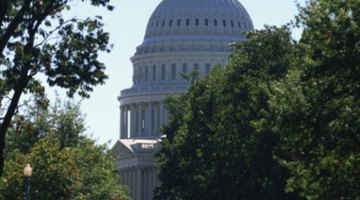Fiscal and monetary policy represent two approaches by which governments attempt to manage their nations’ economies. Fiscal policy uses the government’s taxation and spending powers to influence the economy, while monetary policy uses interest rates and the money supply to ensure stable economic growth. Although monetary and fiscal policy have differing effects, both strive to ensure economic stability.
Fiscal Policy Objectives
Fiscal policy uses taxes, government spending or a combination of the two to affect the overall direction of the economy. Often, government uses fiscal measures to stimulate a troubled economy, as the United States government did during the Great Depression in the 1930s. The government then used a series of new programs and spending measures, such as infrastructure projects, to stimulate economic activity. During a slow economy, firms produce fewer goods and consumers spend less money, lowering the aggregate demand and reducing national economic output. By increasing its purchases of goods and services or by lowering taxes to put more money into people’s hands, government tries to increase aggregate demand and boost output, as measured by the gross domestic product (GDP).
Monetary Policy Objectives
Monetary policy’s main objectives involve ensuring a stable price system and promoting sustainable economic growth. Inflation, characterized by an overall rise in prices, reduces the purchasing power of money and harms economic growth. Monetary policy tries to protect the value of money by regulating the national money supply. Policy instruments for doing so include the sale and purchase of government securities known as open-market operations; regulating banking reserve requirements; and setting short-term interest rates, such as the federal funds rate in the U.S. and the discount rate.
Identification
Different entities control fiscal and monetary policy. In most nations, the legislative and executive branches of government control fiscal policy, setting the tax rate and adopting the government’s annual budget. In the U.S., Congress adopts the budget and sets taxation levels with some input from the president. Central banks oversee monetary policy. Examples include the U.S. Federal Reserve, the Bank of England, the Bank of Canada and the Bundesbank in Germany.
Fiscal Policy Effects
Fiscal policy has its most immediate effect on aggregate demand for goods and services across the economy. Fiscal policy also affects consumer behavior. High marginal tax rates, which charge higher rates as income rises, reduce incentives to earn more money. Expansionary fiscal policy, in which government boosts its spending to stimulate the economy, may crowd out private sector investment, according to Professor Greg Mankiw, a Harvard economist and former White House adviser.
Monetary Policy Effects
By affecting interest rates and the nation’s money supply, monetary policy impacts the ability of consumers and firms to obtain credit. The Federal Reserve Bank of San Francisco, however, reported that monetary policy involves a long-time lag in which it can take three months to over a year for policy decisions to ripple across the economy.
Related Articles
References
Resources
Writer Bio
Shane Hall is a writer and research analyst with more than 20 years of experience. His work has appeared in "Brookings Papers on Education Policy," "Population and Development" and various Texas newspapers. Hall has a Doctor of Philosophy in political economy and is a former college instructor of economics and political science.









